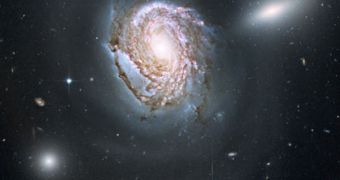In a new series of observations, a team of investigators has recently shed new light on a galaxy located in the large Coma Cluster. The cosmic structure looks stunning in a new photo.
The new observations were conducted using the Hubble Space Telescope, which was last year revamped, and outfitted with new cameras and instruments.
Virtually all of its major components, down to its gyroscopes, were replaced in May 2009, when NASA astronauts flew to the observatory aboard the space shuttle Atlantis.
Now, thanks to the new additions, the telescope is capable of observing the Universe deeper and in more details than ever before.
It is precisely this ability that allows investigators at the Space Science Telescope Institute (SSTI) to look at the galaxy called NGC 4911.
The cosmic structure is located in the Coma Cluster of galaxies, a little more than 320 million light-years away from our planet.
The cluster itself is a collection of more than 1,000 galaxies, but astronomers can focus on whichever of its component they choose thanks to advancements made in imaging technologies.
The new image revealed NGC 4911 to be a majestic spiral galaxy. Located in one of the most crowded areas of the known Universe, the structure feature impressive dark tendrils of gas swirling around it.
The Hubble photo also shows pink hydrogen gas clouds throughout the galaxy, which astrophysicists believe produce massive amounts of new, blue stars.
Due to their large number, these stellar nurseries are most likely very active. Generally, when large amounts of gas are present, the birth and death of stars stirs up the material, causing new stars to be born at even faster rates.
But there's also an external factor promoting intense stellar formation, and that is the collision of galaxies within the cluster, Space reports.
The phenomenon is inevitable when multiple galaxies meet. They continuously merge their matter together, and promote black hole interactions as well.
As result of such collisions, large galaxies develop, which are powered by a supermassive black hole at their cores. These structures usually produce a lot of new stars too. Follow me on Twitter @TudorVieru

 14 DAY TRIAL //
14 DAY TRIAL //